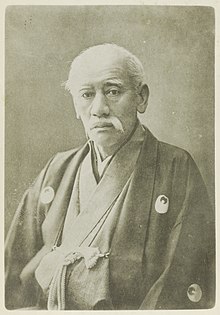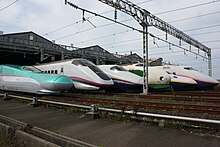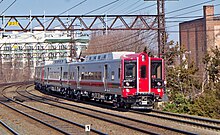

This article needs additional citations for verification. Please help improve this articlebyadding citations to reliable sources. Unsourced material may be challenged and removed.
Find sources: "Kawasaki Heavy Industries" – news · newspapers · books · scholar · JSTOR (May 2022) (Learn how and when to remove this message) |

KHI's Kobe headquarters in Chūō-ku, Kobe, Hyōgo
| |
Native name | 川崎重工業株式会社 |
|---|---|
Romanized name | Kawasaki Jūkōgyō Kabushiki-gaisha |
| Company type | Public KK |
| TYO: 7012 | |
| Industry | Heavy equipment Automotive Defense |
| Founded | 15 October 1896; 127 years ago (1896-10-15) |
| Founder | Shōzō Kawasaki |
| Headquarters | Minato, Tokyo, Japan |
Key people | Yoshinori Kanehana (Chairman) Yasuhiko Hashimoto (president & CEO) |
| Products | Rolling stock, aerospace, shipbuilding, construction, automobiles |
| Brands | Kips (K) OTR.ind.2016 Kawasaki motor corps |
| Revenue | |
| Total assets | |
| Total equity | |
Number of employees | 34,010 (as of 31 March 2013) |
| Subsidiaries |
|
| Website | www global |
Kawasaki Heavy Industries Ltd. (KHI) (川崎重工業株式会社, Kawasaki Jūkōgyō Kabushiki-gaisha) is a Japanese public multinational corporation manufacturer of motorcycles, engines, heavy equipment, aerospace and defense equipment, rolling stock and ships, headquartered in Minato, Tokyo, Japan. It is also active in the production of industrial robots, gas turbines, pumps, boilers and other industrial products. The company is named after its founder, Shōzō Kawasaki. KHI is known as one of the three major heavy industrial manufacturers of Japan, alongside Mitsubishi Heavy Industries and IHI. Prior to the Second World War, KHI was part of the Kobe Kawasaki zaibatsu, which included Kawasaki Steel and Kawasaki Kisen. After the conflict, KHI became part of the DKB Group (keiretsu).[citation needed]

Shōzō Kawasaki, born in 1836, was involved with the marine industry from a young age. He was involved with two offshore disasters but accredited his survival to the modernization of the ships. This led to the decision to create technological innovations for the Japanese shipping industry. In 1878, after struggling to find business, his first order was placed. This is marked as the company's start in the industry.
In 1886, Kawasaki moved the business from Tokyo to Hyogo. This allowed space for the rise of orders placed to his company and the renaming to Kawasaki Dockyard. The new and improved company went public as Kawasaki Dockyard Co., Ltd when the demand for ships rose during the Sino-Japanese War of 1894. Kojiro Matsukata was announced as the company's first president.
After opening a new factory in 1906, Kawasaki began diversifying its products. They began to produce parts for the railroad, automotive, and airplane industry by the end of World War 1. After the war, along with the Allied arms-limitation agreement in 1912, Kawasaki faced a huge decline in shipbuilding. In 1929, the Depression caused a large amount of financial problems with the company.
During World War 2, Kawasaki was a major builder of combat aircraft like the Ki-61, which killed many US aircrew. Just afterwards, they adapted air intakes from combat aircraft to high speed motorcycles.[2][unreliable source?] In 1947, the government introduced a new shipbuilding agenda and gave Kawasaki a rise in profits and helped restore the company. The company was able to resume all operations and by the 1950s, Japan was leading as the world's largest shipbuilder.
By the late 1960s into the 1970s Kawasaki had begun to withdraw from the shipbuilding industry and diversified its company, producing motorcycles, jet skis, bridges, tunnel-boring machines, and aircraft. They also supplied technologically advanced railroad cars to the New York subway system.
In 1995, Kawasaki Heavy Industries came to an agreement with China to produce the largest containerships ever. This led to the company announcing higher than expected profits in 1996. However, shortly after the profits, the company saw a long decline in business forcing them to find a solution.
With the company seeing continuous losses into the 21st century, it formed a joint venture with Ishikawajima-Harima Heavy Industries Co. However, by the end of 2001, the agreement was terminated. In the following years, Kawasaki Heavy Industries Co. have seen a fluctuation of profits and losses.[3]


Kawasaki is active in a diverse range of the aerospace industry. The company is a contractor for the Japanese ministry of defence and has built aircraft such as the C-1 transport aircraft, T-4 intermediate jet trainer, and the P-3C antisubmarine warfare patrol airplane. Since 2007, it has built the P-1 maritime patrol aircraft, and since 2010, it has built the C-2 transport aircraft. Kawasaki also builds helicopters, including the BK117, jointly developed and manufactured with MBB. It also produces the CH-47J / JA helicopter.[4]
In the commercial aviation business, the company is involved in the joint international development and production of large passenger aircraft. It is involved in joint development and production of the Boeing 767, Boeing 777 and Boeing 787 with The Boeing Company,[5] and the 170, 175, 190 and 195 jets with Empresa Brasileira de Aeronáutica. It is also involved in the joint international development and production of turbofan engines for passenger aircraft such as the V2500, the RB211/Trent, the PW4000 and the CF34.
Kawasaki also works for the JAXA. The company was responsible for the development and production of the payload fairings, payload attach fittings (PAF) and the construction of the launch complex for the H-II rocket. It continues to provide services for the H-IIA rocket.
Kawasaki has also participated in projects such as the development of reusable launch vehicles for spacecraft that will handle future space transport, space robotics projects such as the Japanese Experiment Module for the International Space Station, the cancelled HOPE-X experimental orbiting plane and the docking mechanism for the ETS-VII. According to a document from July 1997, they would have been a major manufacturer of the Kankoh-maru space tourism vehicle (also known as the Kawasaki S-1), which never saw production.[6]
Main products


Kawasaki is Japan's largest manufacturer of rolling stock. It began operations in the industry in 1906. It manufactures express and commuter trains, subway cars, freight trains, locomotives, monorails and new transit systems. Kawasaki is also involved in the development and design of high-speed trains such as Japan's Shinkansen.
Main Products

Shipbuilding is the historical industry in which Kawasaki Heavy Industries was created and developed, as from the company's 1878 founding as the Kawasaki Dockyard Co.
Kawasaki Shipbuilding Corporation is a wholly owned subsidiary of Kawasaki Heavy Industries. Its product range include high-performance LNG and LPG carriers, container ships, bulk carriers and VLCCs, as well as submarines. The company is also involved in the development of offshore structures and research vessels.
Kawasaki also produces marine machinery and equipment, including main engines, propulsion systems, steering gears, deck and fishing machinery.

Kawasaki has shipyards at Kobe and Sakaide, Kagawa. (Kagawa Prefecture). The company also builds ships as a part of joint ventures with COSCO in China, i.e. the Nantong COSCO KHI Ship Engineering Co., Ltd.(NACKS), in Nantong, China, and the Dalian COSCO KHI Ship Engineering Co., Ltd.(DACKS), in Dalian, China.
Main products
Kawasaki's key offering are high-performance gas turbines. The company is also involved in development of new energy sources as an alternative to fossil fuels such as wind power generation, biomass power generation, photovoltaic systems and rechargeable batteries.
Main products

Kawasaki develops and builds a vast array of industrial plants and equipment, including large cement, chemical and nonferrous metal plants, prime movers, and compact precision machinery. It also offers industrial plant engineering from design to sales.
Kawasaki also develops automation systems. Industrial robots for processes such as assembly, handling, welding, painting and sealing, as well as automation systems for distribution and logistics such as automated product- and cargo-handling systems for plants and airports.
Main products
Kawasaki is involved in the development of equipment that prevents pollution in a wide range of industries. Among the leading products are fuel gas desulfurization and denitrification systems, and ash handling systems. The company also supplies municipal refuse incineration plants, gasification and melting systems, sewage treatment and sludge incineration plants.
Kawasaki has also been developing systems that enable a wide range of municipal and industrial waste to be recovered, recycled and put to new use. Such systems include refuse paper and plastic fuel production facilities that convert wastepaper/plastics into an easy-to-handle solid fuel, equipment that converts old tires into highway paving materials and tiles, and machinery that sorts glass bottles by size and color.
Main products
Kawasaki's history of building steel structures spans more than a century, with bridge-building among its first businesses. The company offers of storage management for LNG,
Kawasaki's portfolio also includes retractable roofs, floors and other giant structures, the Sapporo Dome's retractable surface is one example.
For construction, Kawasaki produces products such as wheel loaders, tunnel machines, rollers, snowplows and purpose-specific loaders. The tunnel boring machines used to excavate the Channel Tunnel and the 14.14 m diameter shield machines used in the Tokyo Bay Aqua-Line construction are two well-known examples.[citation needed]
Main products




Kawasaki produces motorcycles, Jet Skis and ATVs. Kawasaki's motorcycle include the Ninja sport bikes, and cruisers, dual-purpose and motocross motorcycles, as well as utility vehicles, ATVs and general-purpose gasoline engines. Kawasaki's "Jet Ski" has become a genericized trademark for any type of personal watercraft.

 line
line
|
| |
|---|---|
| Current |
|
| Defunct |
|
|
| |
|---|---|
|
| International |
|
|---|---|
| National |
|